|
[Archive] Star World, German Fairs
Sunday, February 25, 2007
This article contains spoilers. If you read on, please be aware that surprises or secrets may be revealed in great depth This is an archived review and is no longer representative of the ride that it covers. For a list of up to date reviews, please click here If I tell you that Star World is a coaster with spinning cars, I suspect I can predict your reaction. "Whoopee-doo" you'll say, "We need another spinning coaster like a hole in the head". Such a reaction is understandable, for it already seems a long time since spinning coasters were a genuine novelty, a reminder of a golden age when holidaymakers would flock to Virginia Reel coasters. For anyone unfamiliar with the Virginia Reel, these curious rides involved a long zigzag track taken in circular spinning "tubs". Blackpool Pleasure Beach was home to the last remaining Reel, and when this was reluctantly demolished, the days of the spinning coaster came to a temporary end. 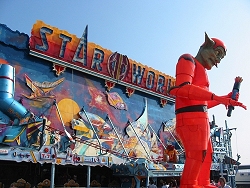 Nowadays, you almost can't move for spinning coasters. Between them, Maurer and Reverchon have flooded the market with rides that range from excellent to poor, and everything in between. Perhaps, though, as we wade through this saturated market, we should remember the ride that for so long kept the flag flying for the spinning coaster concept. Nowadays, you almost can't move for spinning coasters. Between them, Maurer and Reverchon have flooded the market with rides that range from excellent to poor, and everything in between. Perhaps, though, as we wade through this saturated market, we should remember the ride that for so long kept the flag flying for the spinning coaster concept.
Imagine the scene. It's 1992, and we're at the legendary Munich Oktoberfest. Among the array of roller coasters, spin rides, dark rides, sideshows, and other oddities, a new sight homes into view. Presented by showman Klaus Renoldi, this behemoth consists of a truly gigantic building, bearing the name "Magic Mountain". Perched above the entrance is a giant animatronic gorilla, waving apiece of roller coaster track in his humungous hairy hand. Every minute or so, a long roller coaster train skims beneath the primate's posterior, its cars spinning wildly as they go. Clearly this is more than just a big dark ride, it is a fully enclosed and fully portable dark coaster, an ambitious project even by German fair standards. 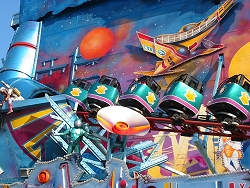 Let's skip forward to 1998. The gorilla has been sold, and enthusiasts have been fearing that Magic Mountain was retiring. Fortunately, the coaster remained, resplendent in a whole new decor, and now bearing the name Star World. The gorilla may have been no more, but this meant that the coaster itself could take centre stage, allowing spectators a much better view of what the ride actually was. Whereas re-theming existing rides often results in fairly insipid efforts (such as Thorpe Park's Rumba Rapids, or Phantasialand's Temple of the Night Hawk), Star World revels in its new identity, and has a unique look, combining the stature of a theme park ride with the OTT glitz of the fairground, with a touch of Blackpool-esque charm for good measure. Let's skip forward to 1998. The gorilla has been sold, and enthusiasts have been fearing that Magic Mountain was retiring. Fortunately, the coaster remained, resplendent in a whole new decor, and now bearing the name Star World. The gorilla may have been no more, but this meant that the coaster itself could take centre stage, allowing spectators a much better view of what the ride actually was. Whereas re-theming existing rides often results in fairly insipid efforts (such as Thorpe Park's Rumba Rapids, or Phantasialand's Temple of the Night Hawk), Star World revels in its new identity, and has a unique look, combining the stature of a theme park ride with the OTT glitz of the fairground, with a touch of Blackpool-esque charm for good measure.
Standing before Star World is an experience in itself. The ride is simply massive, and although it is a cliche (at Coaster Kingdom, we avoid cliches like the plague), you can't stop yourself wondering how on Earth the ride could possibly travel. As if the ride itself weren't impressive enough, a new feature has been added since the re-theme; a natural successor to Magic Mountain's gorilla in the shape of a gigantic robot/alien creature, as tall as the ride itself, who stands at the entrance and serves no purpose other than to attract the attention of passing potential-punters. 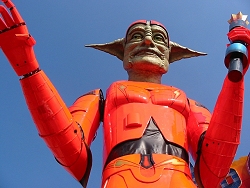 Fully animated, this gentle giant in his day-glo orange space suit spends his days inviting people inside in a variety of languages. If Star World were a theme park ride, this figure's presence would be commendable; that anyone would go to the effort of packing him into a lorry and taking him on tour is astounding. Fully animated, this gentle giant in his day-glo orange space suit spends his days inviting people inside in a variety of languages. If Star World were a theme park ride, this figure's presence would be commendable; that anyone would go to the effort of packing him into a lorry and taking him on tour is astounding.
Now, I don't know about you, but when a 100ft robo-alien tells me to do something, I don't argue, and so I head for the pay box, ready to hand over the very reasonable asking price. Ticket in hand, we pause only to chortle at the various Star Wars figures that have had their appearances hastily altered to avoid the wrath of George Lucas's lawyers, and continue to the loading platform. As is the norm at German fairs, the staff are incredibly efficient, and know exactly what it takes to keep the crowds moving on the rare occasions when a queue manages to build up. As the gates open, you envelope yourself in the deep cocoon-like cars, lower the Break Dance-style overhead lap bar, and prepare for blast-off. 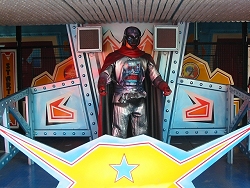 Star World is unusual in that it begins with both a lift hill and a launch. The train slowly climbs around the three inner walls of the building, allowing you plenty of time to take in the laser and lighting effects that fill the void of space. Above your head, some rather tacky Ghost Train style monsters try to intimidate you, and soon the front of the train crests the rise and begins to creep out into the open air. A countdown begins, and on "zero", the train accelerates and zips out for the crowds to see. This will be your last sighting of Earth for a while, so make sure to breathe in the atmosphere (fortunately for you, nowhere on Earth has more atmosphere than a German fair) Star World is unusual in that it begins with both a lift hill and a launch. The train slowly climbs around the three inner walls of the building, allowing you plenty of time to take in the laser and lighting effects that fill the void of space. Above your head, some rather tacky Ghost Train style monsters try to intimidate you, and soon the front of the train crests the rise and begins to creep out into the open air. A countdown begins, and on "zero", the train accelerates and zips out for the crowds to see. This will be your last sighting of Earth for a while, so make sure to breathe in the atmosphere (fortunately for you, nowhere on Earth has more atmosphere than a German fair)
After this bust of daylight, the train returns to the inky blackness for the remainder of the ride. The track proceeds in a seemingly endless series of long sweeps, turns and figure-of-8s that effortlessly flow from one end of the building to the other. Every turn seems designed to encourage the cars to spin a little more, while the pace of the ride never seems to slow, keeping the excitement going until the last moment. 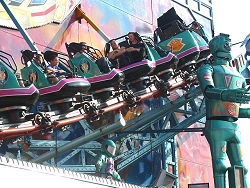 However, Star World is more than just a coaster in pitch darkness. Throughout the ride, laser beams and spotlights do their best to heighten the sense of disorientation, while the finale of the ride sees a large fireball erupt from the ground. Well, to be precise, 50% of riders see a fireball erupt from the ground, as the other 50% will be facing the wrong way. C'est La Vie. Even the brake run is spiced up, taking place within the kind of revolving tunnel usually reserved for dark rides and walk-throughs. Bear in mind that the car itself is likely to be still spinning, and you've got a recipe for some serious disorientation. However, Star World is more than just a coaster in pitch darkness. Throughout the ride, laser beams and spotlights do their best to heighten the sense of disorientation, while the finale of the ride sees a large fireball erupt from the ground. Well, to be precise, 50% of riders see a fireball erupt from the ground, as the other 50% will be facing the wrong way. C'est La Vie. Even the brake run is spiced up, taking place within the kind of revolving tunnel usually reserved for dark rides and walk-throughs. Bear in mind that the car itself is likely to be still spinning, and you've got a recipe for some serious disorientation.
As we pass through the air lock and make our re-entry into the Earth's atmosphere, the staff leap into action, straightening the cars ready for the next troop of space cadets. There's no quarantine procedure for returning astronauts, as the staff sent us on our way at warp-speed. Star World is truly a one-of-a-kind ride. The sheer audacity of travelling such a gigantic structure is something that has to be applauded, and suggests that the ride should be an awful lot more famous than it actually is. It is the kind of ride that any theme park would be proud of, and the only thing that seems to stop it being revered as a true classic is the fact that it has spent its entire existence in the shadow of legendary white-knuckle portable coasters such as Eurostar, Olympia Looping, and the much-missed Thriller. This is a great injustice, as it is a truly excellent "fun" coaster that really can be enjoyed by the whole family. 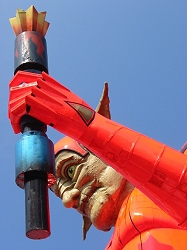 Criticisms? Well, it's harsh, but it's true that the amount of spinning does vary massively from one ride to the next. If your car gathers a little momentum, you can be sent spinning and tumbling through the cosmos like a deranged asteroid. Criticisms? Well, it's harsh, but it's true that the amount of spinning does vary massively from one ride to the next. If your car gathers a little momentum, you can be sent spinning and tumbling through the cosmos like a deranged asteroid.
However, if you're unlucky, you'll get a fairly moderate ride, in which case you'll find that the various lighting effects aren't enough to grab the attention on their own. It feels wrong to criticise the ride in this way, especially as there are plenty of static dark coasters that do a lot less to grab riders' attention, and plenty of spinning coasters that offer far less spinning than even a "bad" ride on Star World. There are plenty of dark coasters in the world, but very few have the panache to really explore the potential of the concept. Star World takes an unusual approach to spicing things up, and as a result is not only one of Europe's better dark coasters, but is also probably Europe's top spinning coaster. Do as the giant robot says, and sign up for a voyage into Star World. It's cosmic. Please, do not use our ratings to compare rides head-to-head. They rate only how well this ride meets its own objectives using criteria that may not necessarily be relevant with similar reviews. 
Good points: - Incredible presentation, both inside and out
- Unusual twist on a tried and tested formula
- Excellent family coaster
Bad points: - Spinning can often be erratic
- Can be slightly rough when cars spin unexpectedly
Labels: Coaster, DarkRides, GermanFairs, SpinningCoaster, Star
Star Flyer, German Fairs
Sunday, February 25, 2007
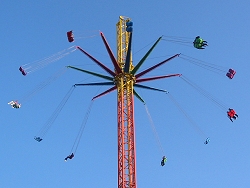 Sometimes you can add two and two and make three. Sometimes you can take the most mouth-watering ingredients and somehow end up with something that tastes like cardboard. Sometimes you can add two and two and make three. Sometimes you can take the most mouth-watering ingredients and somehow end up with something that tastes like cardboard.
The good folk of Austria's Funtime Group obviously saw the universal popularity of the Zierer Wave Swinger, and then the enormous success of the myriad of tower rides littering the world's parks and fairs. They then whipped out their pencils and sketched out a ride that would neatly combine the two. Before you could say "These are a few of my favourite things", the Star Flyer was born. The travelling Star Flyer, like any travelling tower ride, looks mightily impressive. With a dazzling set of patterned lighting running the length of the tower, it functions as a beacon for fair-goers, and a perfect advertisement for whatever event it visits. The brightly coloured seats and star-shaped structure combine with the strategically placed floodlights to make quite a majestic sight when the ride is in motion. 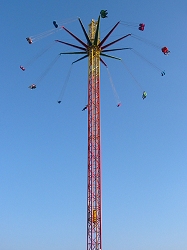 Getting closer, the standard of presentation is high. The huge number of flashing signs ensures that the ride's name remains burned into your retinas, as does the huge backflash that sits atop a parked lorry at the rear of the platform. Everything looks set for a truly extraordinary ride. Getting closer, the standard of presentation is high. The huge number of flashing signs ensures that the ride's name remains burned into your retinas, as does the huge backflash that sits atop a parked lorry at the rear of the platform. Everything looks set for a truly extraordinary ride.
So, having exchanged your cash for a token, you head to your seat and prepare to do battle with the spider's web of seatbelts, chains, and restraints. Those of us who can remember when even theme park Wave Swingers relied on nothing more than a bar to separate you from a messy doom will be amazed at the rigour with which you are held in your seat, to the extent of an electronically locked belt to hold the lap bar in place. Unlike most Wave Swingers, Star Flyer offers all double-seats so that your flight needn't be solo. And we have lift-off. OK, I use "launch" more in the Detonator sense than Power Tower, but as we move up the tower, the star begins to turn and the seats begin to fan out into a wide circle. Time to see what this supersized Chair-O-Plane can really do. 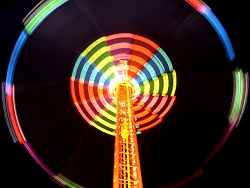 Up and up, and round and round, and up and up, and round and round we go. Up and up, and round and round, and up and up, and round and round we go.
Then down and down, and round and round. Then up and up, and round and round. Then down. I'm sorry if this doesn't sound like the most exciting piece of prose you have ever read, but let's be completely honest, there's nothing else to be said. If Star Flyer was designed as a combination of a Wave Swinger and a Shot 'n' Drop, then there's two things that were left out at the planning stage. 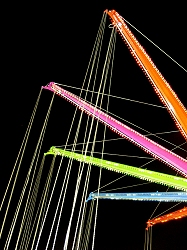 1: The Wave Swinger is a fun ride because of the wave element. 2: The Shot 'n' Drop is a fun ride because you can feel the shot, and feel the drop. 1: The Wave Swinger is a fun ride because of the wave element. 2: The Shot 'n' Drop is a fun ride because you can feel the shot, and feel the drop.
What we're left with is a ride that, in all honesty, is little more than an observation tower that looks like a thrill ride. As such, it is difficult to know what to make of it. If you buy your token expecting a thrill ride, you will be left feeling let down, whereas anyone looking for an observation ride will almost certainly find a Ferris Wheel nearby to do the job far better. Sure it's a nice novelty, but it soon wears thin. The frustrating thing is that it would not take much to turn Star Flyer into a highly enjoyable ride. Make the climbs and drops a little sharper so that riders notice them. Turn half the seats backwards so that riders can see each other, and run the ride in both directions. Install some speakers in the tower and let riders listen to the same music as the spectators. As it is, Star Flyer relies on nothing but its height to excite riders, and that's a novelty that is never going to last long. 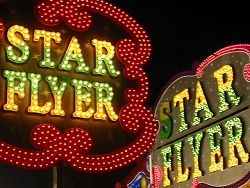 Even the length of the ride is a dichotomy. On the one hand, it is far too short, particularly for a fairground ride, where neighbouring competitors are likely to be charging less money for significantly longer rides. Even the length of the ride is a dichotomy. On the one hand, it is far too short, particularly for a fairground ride, where neighbouring competitors are likely to be charging less money for significantly longer rides.
On the other, the ride is so repetitive that you are hardly likely to be left wanting more. It is certainly difficult to imagine anybody leaping from their seat and reaching for their wallet to go and buy another token, that's for sure. 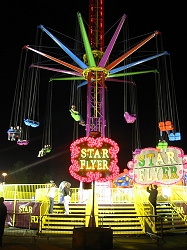 I truly wanted to like Star Flyer. I loved the idea of a gigantic Wave Swinger, but Star Flyer simply isn't the ride I'd been hoping for. I hate to say it, but this is one to consign to the "All mouth and no trousers" category. I truly wanted to like Star Flyer. I loved the idea of a gigantic Wave Swinger, but Star Flyer simply isn't the ride I'd been hoping for. I hate to say it, but this is one to consign to the "All mouth and no trousers" category.
Still, maybe we should just accept that, like Big Ben and perhaps even Power Tower 2, Star Flyer functions best as a way of attracting punters to the fair. Once they've been lured in, they'll hopefully find something a bit more substantial to keep them happy. Star of the show? Nope, just a flight of fancy. Disappointing. Please, do not use our ratings to compare rides head-to-head. They rate only how well this ride meets its own objectives using criteria that may not necessarily be relevant with similar reviews. 
Good points: Bad points: - Although tall, it is a short and repetitive ride with a lack of atmosphere
- Star Flyer is a waste of a potentially brilliant idea
Labels: 1Star, GermanFairs, SpinRide, Star
Star Tours, Disneyland Paris
Saturday, February 24, 2007
This article contains spoilers. If you read on, please be aware that surprises or secrets may be revealed in great depth The films of the Star Wars trilogy are perhaps the most epic, profound and astounding scenes ever set into celluloid, the most appreciated movies ever and the one of the most well known pictures ever filmed, even twenty years on. If done well, to theme a ride after these films would be a recipe for success. It would be easy to make a mess of the very name of Star Wars, but with the Disney Imagineers at the helm of this galactic trek through the void of theme park attractions, we were pretty much guaranteed a immersive attraction doing justice to the films. After all, George Lucas is the movie-mogul, Disney are the ride experts. A match made in the stars, perhaps. Spreading like space-dust in the big bang, simulators were the flavour of the month towards the end of the 1980s. Although most were just the embarrassingly basic washing machine experience, all-time greats such as Back to the Future dressed the simulator in crown and robes, ready to throw the roller coaster off the thrown to proclaim itself king of the park. By the time Star Tours opened in Paris, people had woken from their dream world, realised that the simulator was only as versatile as the film inside, and the ride took its place behind the roller coaster in the messy hierarchy of theme park attractions. Unlike most rides at Disneyland Paris, Star Tours hasn't evolved and is identical to the American (and Japanese) versions, with even the queue being identical. The evident difference is that the majority of dialogue is now conducted in French. Although Disney is reputed to be the market leader in theming, there are many strange divergences in theming. Adventureland is perhaps the most obvious example, home to the Swiss Family Robinson, the Pirates (of the Caribbean) and Indiana Jones' deserted campsite. Another is that in contrast to the lush and spectacular brass and gold Victorian architecture of Discoveryland, nestled behind Space Mountain is the white panelled 'Space Port', the entrance of which is marked by an X Wing Fighter arching over the queue-line. The first part of the queue is pure tedium. With the creativity of beans on toast, you zig-zag almost endlessly. There is nothing to look at other than the back of Space Mountain and the ramp going up to the Disneyland Railroad station above. The queue gets far better though. You soon enter the building, and like something from Space Station Zero (previously Thorpe Park), intergalactic maps of the universe light the inky darkness. In a large hall, the queue zig-zags up and around a series of ramps. Promotional footage plays on a video wall above - 'come ride a tauntaun!', 'visit Endor!' - airport-style announcements in French, English and Alien and a galley of aliens look down on proceedings below. More familiar to some, droids service a Star Speeder 3000. R2D2, the loveable bleeping rubbish bin, stands upon the roof, C3PO, more camp than a row of tents, watches over proceedings. As if you watch the film, like a couple of fishwives, the two spend more time chatting than servicing, hardly bolstering your confidence in Star Tours. Lights flash aggressively on the control panel that C3PO looks over, smoke fires out of split pipes. Though a small tunnel, you enter a workshop with an overhead track taking baskets of spare parts around your head. Below, parts of robots are scattered, droids await repair and lay discarded. It is after this that you enter the main terminal. A member of staff will ask the obligatory question of how many of you there are, before sending you to a relevant gate. Each gate consists of a row of five numbered doors. Riders queue up as the riders before enjoy the ride on the opposite side of the doors. Above, televisions continue to promote the services offered by Star Tours before continuing with safety announcements. The safety announcements are a pleasure to watch. Like many Disney safety films, tongue-in-cheek humour is evident throughout. Everyone watches, and by the time it is time to load, everyone is au-fait with how to secure loose articles and, indeed, themselves. The doors open and you board your Star Speeder, like the one the droids were earlier maintaining. You cross the gantry and though the doors into the plush interior. Rows of seats span the cabin, and once seated, you pull the retractable seatbelt across your lap, stowing your loose bags and coats under your seat. A ride operator briefly checks everyone is comfortably secured before the doors swing shut. A small screen on your right bursts into life. Rex, our pilot introduces himself. Looking like something 'made earlier' on Blue Peter, he hardly bestows confidence – 'Your first flight? Mine too!' Before we depart for the moon of Endor, the cockpit shield lowers to show the Star Speeders' wide windscreen and Rex in real life to our left. Our navigator, R2D2, appears on the screen to our right, and we begin taxiing though the space-ports' corridors. We follow an identical Star Speeder which heads towards the launching area, and in a flurry of radio announcements, our Star Speeder veers suddenly to the left towards the maintenance bay. We soon drop down violently off the edge of the taxiway in the maintenance bay before swooping out into space. As soon as we're stable again, we accelerate up to light speed. As a corridor of streaking stars envelops our craft, and we are pinned back into our seats as we head through darkest space. Not long after this acceleration, 'Approaching Endor' appears on the television screen to our right. Soon after, 'Leaving Endor' replaces it. Anything else want to go wrong? Too right it will. As we slow, we approach a field of comets. As we violently dodge around them, few hit before we have no option but to go into the larger one that would have invariably destroyed our ship. We now slalom around the innermost crystallised catacombs of this meteor, before we head towards a wall, when the end seems inevitable we smash violently through the wall of ice and back into space. Phew. As we recover, the ship pitches to the right and to the dramatic Star Wars theme, is pulled towards an Imperial Star Destroyer and into the midst of a dogfight between the X Wing Fighters and Tie Fighters. Video contact is made by an X Wing pilot who instructs us to ease off the tractor-beam and follow him. As we do, we head down towards the surface of the Death Star into one of the trenches formed by the many openings and gaps in the structure. Dodging fellow X Wing Fighters, in a blaze of laser fire we dodge explosions and blasts from Tai Fighters desperately (and in vain) protecting Death Star. As we pass the exhaust of the Death Star, an X Wing fires shots down before we pull up, a wall of flames erupting from the Death Star, engulfing the whole man-made planet-destroyer in an explosion of incredible proportions. As we pull away, on the X Wing pilots' orders, we accelerate up to light speed, pinned once again against our seats before we slow, approaching the Star Tours space port, joining the queue of Star Speeders taxiing back. As we head steadily towards a tanker marked 'flammable', Rex brakes, and just as a collision seems inevitable, we jolt to a sudden halt before we slowly go down to the point where we boarded. As the partition rises, and we say goodbye to Rex, the doors on our right swing open and we follow the long corridor back to relative normality. Star Tours exhibits the full capabilities of a simulator, how the simulator can form an integral part of an experience as opposed to forming the entire basis of an attraction. Unlike many film-orientated attractions, no familiarity of Star Wars is required, no knowledge of the rides' plot is needed. This is made all the more impressive when the general contour of the ride is conveyed through the queue-line with such touches as the promotional intergalactic holiday footage and the 'final boarding for flight 11-19' type announcements. For kids too young to pick up these subtle touches, the bickering droids, R2D2 and C3PO will more than entertain, as will the many other humorous effects. And then the actual simulator part ties in perfectly, more so than perhaps on any other. Like boarding a flight, you get the safety announcements, the queuing at the door, the pre-flight announcements, belting yourself in, the captain introducing himself... And the film that goes with the ride is perfect. It is entertaining enough not to intimidate children, dark and dramatic enough not to make a mockery of the film, and oscillates successfully between smooth space flight, accelerating up to light speed and rough dogfights and meteor storms. The ride is perfectly timed to the film, so people won't be reaching for sick-bags, and although you are thrown around, it remains smooth enough so that you don't come of with bruises. If you lift your feet up, and are in the back where movements seem to be more dramatic, it feels just out of control. Although the ride is best in the front seat, the rows of people in front don't detract from the ride. You don't go skiing, for example, on a chair in a room full of people. The whole guise of the ride, whereby you are in a spacecraft works well, and means it feels far more real than many other simulators. A lot of work has clearly gone in to make the simulator as apt as possible. The flawed flight will leave everyone entertained, and Star Tours is perhaps the most thrilling family ride in the whole park. Please, do not use our ratings to compare rides head-to-head. They rate only how well this ride meets its own objectives using criteria that may not necessarily be relevant with similar reviews. 
Good points: - One of the better simulator rides with excellent back-story
- The Star Wars name gives the ride a lot of credibility and means it is a story many can relate to
- Despite being narrated in French, the ride is still entertaining for all nationalities
- Entertaining queue line - and rarely much of a queue to speak of
Bad points: - Theming clashes with the Jules Verne theming elsewhere in Discoveryland
- It is a simulator, a concept often frowned upon for already being dated
Labels: DarkRides, DisneylandParis, Star
Eurostar, German Fairs
Friday, February 23, 2007
No matter how hard you try, you simply can't prepare yourself for your first visit to a German fair. However high your expectations, I defy anyone not to spend their entire visit uttering the words "How can that thing travel?" every thirty seconds or so. Even when you should be used to it, there are some rides that retain this sense of mystique and wonder, and none more so than Eurostar. This epic tangle of dark purple track would be a jaw-dropping sight at any theme park, but the very idea that the whole thing is temporary simply catapults the ride over the edge of believability. As if that weren't enough, it also just happens to be one of the most frantic, intense, and exhilarating coasters you could ever wish to ride. Debuting in 1995, just eighteen months after Alton Towers' Nemesis became Europe's first inverted coaster, Eurostar is a testament to the fierce rivalry that exists between German showmen. Indeed, the idea that anyone ever seriously thought about making a travelling inverter of this size is amazing, but to then make it a reality is quite simply mind-blowing. 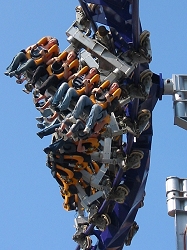 Until Eurostar came along, Germany's tradition of large travelling coasters had stalled slightly. Anton Schwarzkopf, the mastermind behind the likes of Thriller and Dreier Looping, had fallen ill. His last major travelling coaster was 1989's Olympia Looping, while the only other major coaster to appear in this respite had been 1992's enclosed family ride, "Magic Mountain" (now "Star World"). Oscar Bruch, Germany's most famous showman, had been touring his two large coasters, Thriller and Alpina Bahn, for over ten years, and wanted to add something new to his line-up. Until Eurostar came along, Germany's tradition of large travelling coasters had stalled slightly. Anton Schwarzkopf, the mastermind behind the likes of Thriller and Dreier Looping, had fallen ill. His last major travelling coaster was 1989's Olympia Looping, while the only other major coaster to appear in this respite had been 1992's enclosed family ride, "Magic Mountain" (now "Star World"). Oscar Bruch, Germany's most famous showman, had been touring his two large coasters, Thriller and Alpina Bahn, for over ten years, and wanted to add something new to his line-up.
Meanwhile, B&M was setting the theme park world alight with their new inverted coasters, and so this seemed the obvious direction for Bruch to take. The trouble was that few people were willing or able to take on the massive task of a full-size travelling inverter. As a result, the project came to involve people and companies from all over the continent, an arrangement that provided the inspiration for the ride's eventual name. Officially, the ride comes from Intamin, although much of the work was sub-contracted to Giovanola, a company that had worked with B&M and would later go on to build coasters under their own name. As for the design, this came from the then-relatively unknown Werner Stengel, who had worked extensively with Anton Schwarzkopf on previous travelling coasters. In addition, the Bruch family were also heavily involved with the design, both in terms of how they wanted it to ride, and how the massive structure could be made easier to transport. It's worth pausing to think exactly what considerations needed to be made in designing this ride, as they go far beyond anything a theme park ride would need to worry about, and make it easier for us to appreciate what a huge accomplishment Eurostar is. 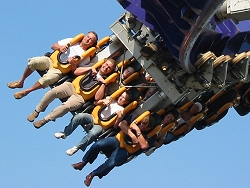 Firstly, the ride needed to be comparable to previous travelling coasters both in terms of ground space, and the time required to build and dismantle. As such, the ride used a similar "plug and socket" structure to the Schwarzkopf coasters. This allowed the ride to be pieced together with minimal fuss, allowing it to be booked onto as many fairs as possible each year, while minimising the need to hire local people to help build and dismantle the ride at each location. Firstly, the ride needed to be comparable to previous travelling coasters both in terms of ground space, and the time required to build and dismantle. As such, the ride used a similar "plug and socket" structure to the Schwarzkopf coasters. This allowed the ride to be pieced together with minimal fuss, allowing it to be booked onto as many fairs as possible each year, while minimising the need to hire local people to help build and dismantle the ride at each location.
Secondly, while the structure needed to be strong enough to cope with the enormous stresses involved, it needed to be slender enough to pack onto as few lorries as possible in order to reduce the transportation costs. It's no use having a world-class coaster if you have to charge people more to ride it than they're willing to pay. Thirdly, anyone who has visited a busy German fair will know that the crowds can be colossal. Indeed, the top German fairs attract more people in their 1-2 two week run than most major theme parks get all year. As such, a major coaster needs to have an astronomically high capacity, as you obviously want to get as many people through the gate as the fair's opening hours allow. As such, Eurostar needed to match the ferocious capacity of Schwarzkopf's legendary crowd-crunchers, and is capable of running four 28-seat trains at peak times, forcing staff to maintain loading times far faster than most theme park coasters. Fourthly, the ride simply needed to look good. Remember, the ride operates in a pay-per-ride environment, and needs all its elements to be clearly visible in order 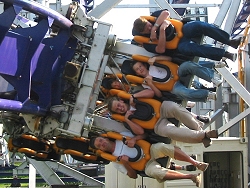 to entice spectators to the paybox. Again, you could have the greatest coaster on the planet, but if it doesn't grab the interest of passers-by and make them want to open their wallets for tickets, it will fail. Schwarzkopf's travelling coasters were a masterclass of "staging", with the lift hill and bigger drops at the back of the ride, and other major elements, such as inversions, perched in the foreground, and often right above the paybox for maximum visual impact. to entice spectators to the paybox. Again, you could have the greatest coaster on the planet, but if it doesn't grab the interest of passers-by and make them want to open their wallets for tickets, it will fail. Schwarzkopf's travelling coasters were a masterclass of "staging", with the lift hill and bigger drops at the back of the ride, and other major elements, such as inversions, perched in the foreground, and often right above the paybox for maximum visual impact. Finally, and most obviously, it has to be a good ride. It doesn't take a genius to work out that you can at least double your revenue by offering a coaster that people will want to re-ride. If you get off the ride without having enjoyed it, that's one more ticket that will go unsold. So there you have it. Versprung durch Technik. Would you fancy trying to design a coaster within these limitations? No, and neither did a lot of other people. It was immensely brave of Werner Stengel to accept the challenge, especially as he was not the legendary figure he is today. Indeed, Eurostar was arguably the first time that Stengel would be regarded as the "star" designer, rather than remaining an anonymous back-room boffin. Despite opening late at its first few fairs, Bruch's battalion of staff soon managed to find ways of building the ride in less and less time, and using less and less trucks. Nowadays, the whole process goes with military precision, and the ride is always ready for business when the fair opens. 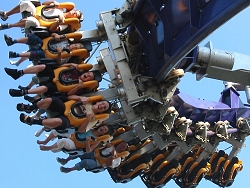 So, we find ourselves standing before the mountain of steel that is Eurostar. Certainly, the need to look good has been met. The ride is staged beautifully, with the twisted first drop in the background, the huge loop dominating the mid-ground, and a lightning fast in-line twist being performed above the paybox and queue. Keep watching, and you'll see the train plough through the twin corkscrews that form one of the ride's many high-speed, high-drama, high-G highlights. At night, the subtle floodlighting reflects beautifully on the structure, giving the ride a gloriously intimidating aura as the trains blur past in all directions. So, we find ourselves standing before the mountain of steel that is Eurostar. Certainly, the need to look good has been met. The ride is staged beautifully, with the twisted first drop in the background, the huge loop dominating the mid-ground, and a lightning fast in-line twist being performed above the paybox and queue. Keep watching, and you'll see the train plough through the twin corkscrews that form one of the ride's many high-speed, high-drama, high-G highlights. At night, the subtle floodlighting reflects beautifully on the structure, giving the ride a gloriously intimidating aura as the trains blur past in all directions.
At the paybox, a ticket is received for less money than you might reasonably expect, and it is time to join the fast-moving queue. As with many German fair rides, "queue" is not really the appropriate word, as it tends to move at close to walking pace, and so what might look like an hour's queue dissolves in minutes. As you approach the station, prepare to be in awe of the staff. Usually, when we praise ride staff, it is for their friendliness, but here it is for the ferocious efficiency with which they operate the ride. Forget about politeness, if your group can fill those last few seats, prepare to be virtually grabbed by the neck and thrown into the train. For theme park devotees, this will be yet another indication of the fact that the German fairs are a whole new world, with an unprecedented sense of haste and urgency. The trains themselves resemble stripped-down B&M cars, with none of the niceties that we associate with Walter and Claude's luxury vehicles. No seatbelts, no moving floors, just the bare minimum needed to hold you in your seat, and to keep the trains running like clockwork. Indeed, when you've ridden Eurostar, the B&M inverters suddenly seem needlessly complex. 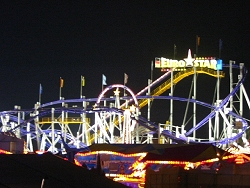 At the sound of a hooter, the train charges away to the rear of the ride, where it engages the deafening lift hill. From here, we are thrown straight into an inverted equivalent of the famous Schwarzkopf twisting first drop, and into the vertical loop with all the speed and fury of a rampaging rhinoceros. Front seat riders will get the first of many scares, as pieces of structure fly past at a proximity that makes them half-expect the ride to trim their toenails for them. At the sound of a hooter, the train charges away to the rear of the ride, where it engages the deafening lift hill. From here, we are thrown straight into an inverted equivalent of the famous Schwarzkopf twisting first drop, and into the vertical loop with all the speed and fury of a rampaging rhinoceros. Front seat riders will get the first of many scares, as pieces of structure fly past at a proximity that makes them half-expect the ride to trim their toenails for them.
No time to recover, as the train barges into an overbanked turn, ripping wildly to the left as it prepares to soar across the station roof and into the ferocious in-line twist. As with much of the ride, it may lack the grace of the B&M inverters, but what it lacks in finesse, it more than makes up for in sheer aggression. No coaster, Nemesis included, makes you feel so puny in the face of a rampaging typhoon of a ride. Tearing out of the inline twist, it's time to hit the first set of brakes. Now, it's conventional to bemoan the braking of coasters, but Eurostar is slightly different. While the brakes need to be there to allow the operation of so many trains, the fact that the train slows to a crawl actually serves as a well-earned breather, before hurtling back into the unadulterated mania of the ride. Indeed, if the train were allowed to charge on at full speed, it's doubtful that the riders would live to tell the tale. The next section simply oozes quality. After a swift drop, the train curls straight into two consecutive corkscrews, both tighter than you would ever think possible at this speed. With its passengers thoroughly disorientated, the train finds itself needing to perform a turn that may well rank as the most intense piece of coaster track on Earth. If you are still conscious enough to know what is going on, this near-hairpin turn pulls enough G-force to send blood rushing straight to your feet, a sensation quite unlike anything other coasters can offer. 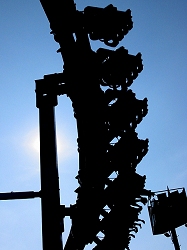 Into another brake run, and the train again slows to a crawl. With all the inversions over, is this the point where the ride calms down? Not a bit of it, for Eurostar has one last trick up its sleeve. Twisting to the right, the track drops into a helix. The speeds get higher and higher, and the turn gets tighter and tighter, and soon riders are feeling the kind of G-force make them fear that the fillings are going to be ripped from their teeth. After what seems like an eternity, the train is effortlessly spat into the final brakes, which accurately simulate the feeling of being smashed into a badly placed brick wall. Into another brake run, and the train again slows to a crawl. With all the inversions over, is this the point where the ride calms down? Not a bit of it, for Eurostar has one last trick up its sleeve. Twisting to the right, the track drops into a helix. The speeds get higher and higher, and the turn gets tighter and tighter, and soon riders are feeling the kind of G-force make them fear that the fillings are going to be ripped from their teeth. After what seems like an eternity, the train is effortlessly spat into the final brakes, which accurately simulate the feeling of being smashed into a badly placed brick wall.
The organised chaos of the station throws you onto the exit platform, and down an exit path that continues the intimidation by sending trains roaring past at furious speeds. This primeval language of roars and screams can only translate to a challenge to re-ride. Eurostar is devastatingly awesome. No ride can match it for maniacally grabbing riders by the throat and taking them to the limits of endurance. If you are looking for a passive, calming experience, look elsewhere; Eurostar caters for those of us who like a coaster to show no mercy, to seize us and challenge us to battle it out, to prove our mettle. Once you have ridden Eurostar, it is difficult not to snigger at the thought of Alton Towers advertising Nemesis as "The world's most intense roller coaster experience". Compared to Eurostar, Nemesis is about as intimidating as a newborn kitten. There is, however, one accusation that many riders levy, and it one that that I intend to rebuke with every breath in my body. Ladies and gentlemen, Eurostar is not - I repeat NOT - too rough. Not by a long chalk. Let me explain: Sure, it's not smooth in the B&M sense of the word, but that certainly isn't something that should be seen as negative. If anything, its undoubted brutality simply serves to emphasise the sense of incredible dominance the ride has over its pray. Even in the back seats, where the G-forces are enough to totally disorientate riders, the experience never crosses the line into discomfort. When you ride Eurostar, you simply have to do exactly that - RIDE it, in the way you would a bucking bronco. There really is no point in sitting impassively in your seat and expecting to glide through its impossibly tight corners, as you'll come off second best. Eurostar is fierce, ferocious, wild, untamed and menacing. As a rider, it demands that you are prepared to do battle, and for those who are, the effort is rewarded tenfold, as the ride will get the adrenalin pumping in a way that few other coasters can ever hope to match. As someone who loves a ride that makes it clear who wears the trousers, I firmly believe Eurostar to be everything you could possibly want a coaster to be, and is one of the greatest rides you could ever hope to find. It has no airs or graces, it doesn't mollycoddle riders, it just does its job of terrorising hapless riders, and does it to perfection. It exudes a tangible aura of pure aggression, and never lets you forget that you are on its territory and have to play by its rules. Do that, and you'll soon realise that the real king of wild-and-furious inverted coasters does not reside in a Staffordshire crater, but is instead constantly prowling around the showgrounds of Germany. Long may it reign. Please, do not use our ratings to compare rides head-to-head. They rate only how well this ride meets its own objectives using criteria that may not necessarily be relevant with similar reviews. 
Good points: - Utterly ferocious
- Some of the most intense elements ever built
- Impeccable operation and capacity
Bad points: Labels: Coaster, GermanFairs, Intamin, Recommended, Star
|